#kimberella
Explore tagged Tumblr posts
Text

My 25 years of palaeoart chronology...
In 2013 I built 23 scale and life-size models for MUSE Science Museum, in Trento, Italy. Here's Kimberella, from the Ediacaran.
#Art#Painting#PaleoArt#PalaeoArt#SciArt#SciComm#DigitalArt#Illustration#Dinosaurs#Birds#Reptiles#Palaeontology#Paleontology#Ediacaran#Kimberella#JurassicWorld
243 notes
·
View notes
Text
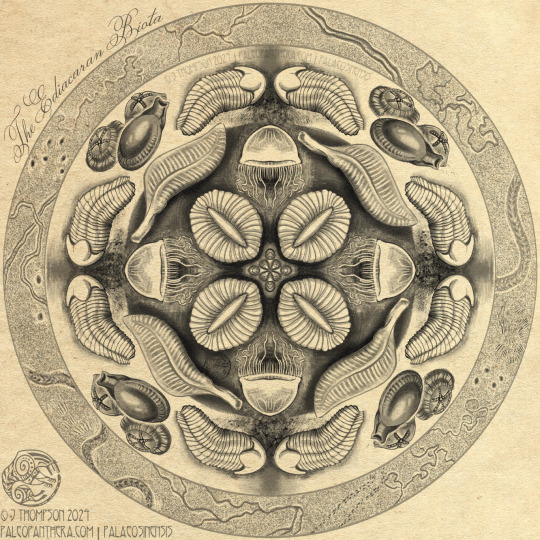
Alright science art and paleo art folks go gentle on me. If I was to do these for a gallery showing I think I'd need at least a couple of weeks for research and notes alone. More if I reached out to researchers for paper access and feedback. Speculative armored invertebrates, Dickinsonia, speculative medusa, Charnia, Spriggina, Kimberella, Arkarua, & their trace fossils.
#ancient life#fossil#fossils#ediacaran#science art#paleo art#dickinsonia#charnia#spriggina#kimberella#arkarua#trace fossils#art#drawing#digital art#illustration#palaeosinensis#paleo panthera#paleopanthera#mandala#pencil#digital pencil#reconstruction#paleoart#paleontology#prehistoric#prehistoric animals#animals#ancient
77 notes
·
View notes
Text
Links in lieu of propoganda. Kadimakara, a triassic archosauromorph reptile

Kalisuchus, a triassic archosauromorph reptile

Kambara, a cenozoic crocodile

Kimberella, a precambrian bilaterally symmetrical animal

Kolopsis, a cenozoic diprotodontid marsupial
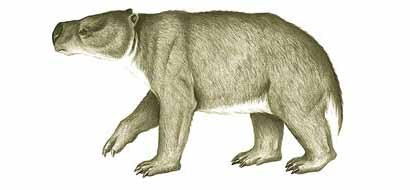
Koolasuchus, a cretaceous temnospondyl amphibian

Kronosaurus, a cretaceous marine reptile

Kunbarrasaurus, a cretaceous armoured dinosaur
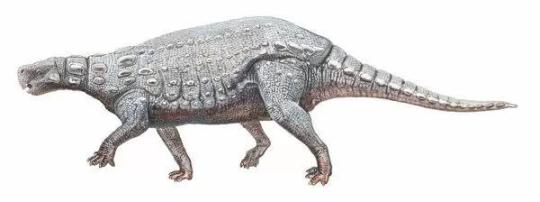
#please reblog#feel free to advocate for your favourite#palaeoblr#australian fossil alphabet thing#dinosaur#megafauna#kadimakara#kalisuchus#kambara#kimberella#kolopsis#koolasuchus#kronosaurus#kunbarrasaurus
60 notes
·
View notes
Text
Kimberella! The problematica party is here to make you question all facets of phylogeny!
Get this sticker here!
13 notes
·
View notes
Text
Kiffer, the Patchwork Pokemon!
Type: Fire
Evolves into Hemaslime when holding an Iron Ball Upturning the sediment for food with their proboscis, Kiffers scootch slowly across the seafloor. To better protect themselves, they will sometimes heat up and harden the surrounding minerals into more solid plates, which it will pick up and place along its back.

9 notes
·
View notes
Text

At the start of the Neoproterozoic, the first animals would emerge, and after surviving another series of ice ages, we would see the first complex life, although for now it is still very simple and seemingly alien. It is still a subject of debate how these creatures fit into the tree of life. Are they the earliest ancestors of modern life? Are they simply an entirely separate branch that died off after this period? Scientists still aren't sure. I may do a separate post about the bizarre fauna of the Ediacaran period.
At this point we're already around 4 billion years into the story of Earth, with only about 500 million years to the present. Tomorrow we will be exploring a whole new eon.
#Ediacaran#journey through time#paleoart#paleontology#evolution#Neoproterozoic#proterozoic#precambrian#charnia#dickinsonia#spriggina#kimberella#haootia#tribrachidium
13 notes
·
View notes
Text
Molluscs may have been among the earliest life on Earth. My snails come from a line, hundreds on millions of years long, of guys who moved toward food and munched it with comical little mouths. They continue this wonderful tradition in a jar on my desk. I am proud of them.
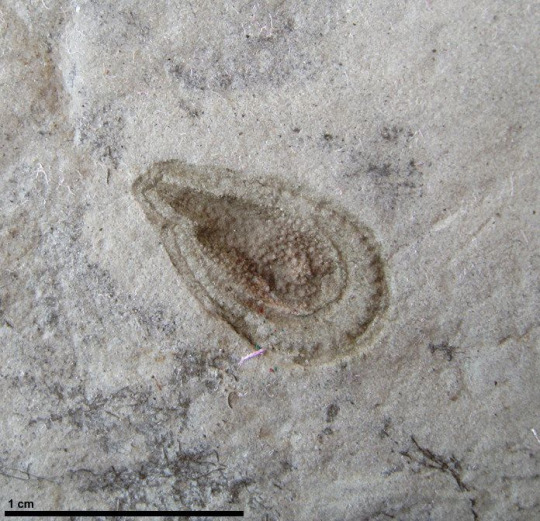
Like this *might* be the ancestor of the guys in a jar next to me. It's from like 558-555 million years ago. "The slug-like organism fed by scratching the microbial surface on which it dwelt", just like my fellas are doing as I write this. (Image, info, & quote source: https://en.wikipedia.org/wiki/Kimberella ).
1 note
·
View note
Text

doodle page 1
17 notes
·
View notes
Text
Anyway wip of aforementioned drawing. Kaito + Kimberella

#art talks about stuff#please ignore kimberella's appearance i only found out that the depiction i'm familiar with is outdated while l was writing that id orz#i will fix it later dw#id in alt text
6 notes
·
View notes
Text
It's a true fact! There are several, deeper, ways for this to be true but on the first level, the linings of both the mouth and the rectum are mucous membranes, so they have similar cell structure and function.
They are also the first structures to form in the fetuses of most species including humans (and reindeer! 🦌) - the egg is fertilized and begins cell division; the cells form a disc shape; the disc shape dimples on one side; then the dimple deepens to turn the disc into a donut shape. One side of the donut becomes the mouth, the other becomes the anus! Thus from the very start, butt and mouth is the same tube.
(This art fucking rocks my socks off btw)

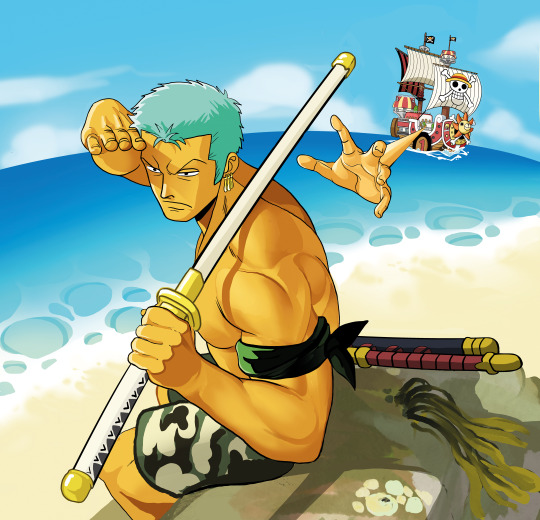

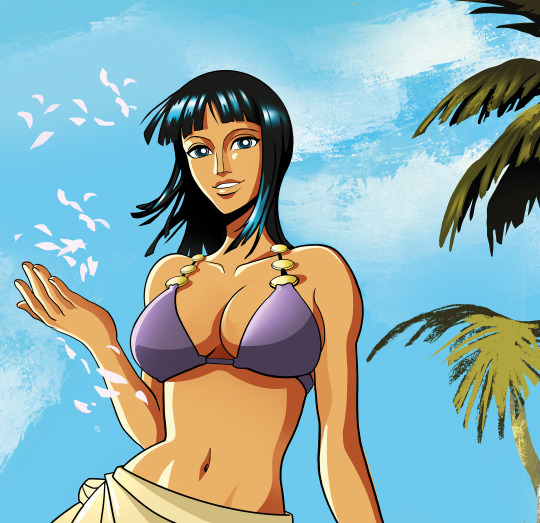



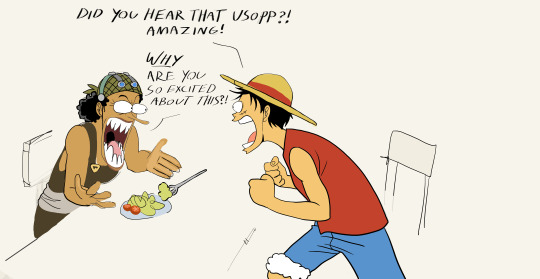
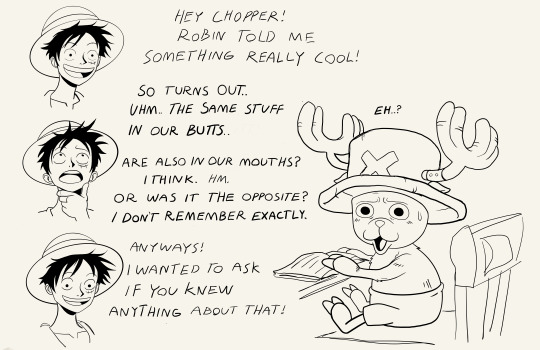
Many one piss drawings.
Not all of these are finished but they’re good enough to post.
Also to be clear,I don’t actually know how true Robin’s trivia is, i just took it from a “Fun facts about the human body” list. (But also i couldn't find anything that disputed this? Ah! So it's a mystery fact!)
Luffy and Robin 🤝 Being neurodivergent about silly things.
#op tag#med info tag#sorry for this whole long thing yall but i am incapable of stopping myself#bc i am also 🤝 w robin and luffy and being neurodivergent about specific things#*silly things sry#im extremely luffy in this scenario. hearing a fun gross medical fact. screaming abt it to a guy just tryin to eat thwir salad#also this made me go on a huge long wikipedia hole journey about. well. holes#proteostomes n deuterostomes and kimberella and cambrian molluscs......#mucousy hole boys. in the cambrian age. the cool shit yknow
3K notes
·
View notes
Text
Round 2 - Mollusca - Polyplacophora
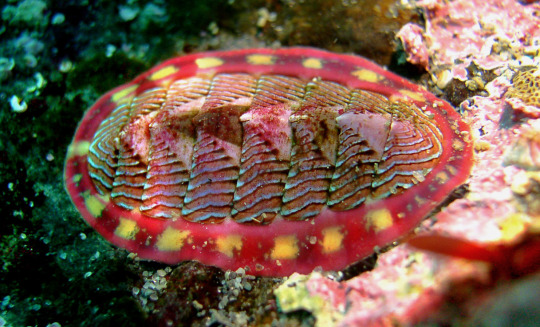
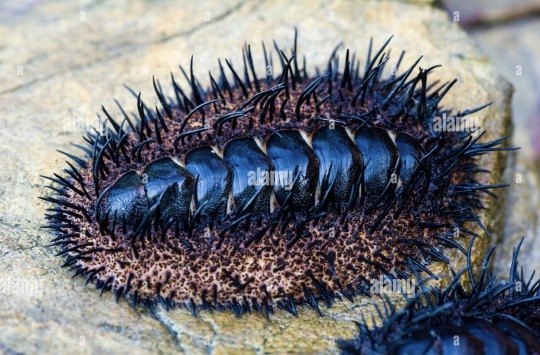


(Sources - 1, 2, 3, 4)
Our first class of molluscs is Polyplacophora, commonly known as “Chitons”, and less commonly known as “Sea Cradles”, “Coat-of-mail Shells”, or “Suck-rocks”.
Chitons have a shell composed of eight separate plates, or valves, which overlap slightly. This allows the chiton to have protection without sacrificing flexibility, as the plates allow for some articulation and even for the animal to curl up into a ball when dislodged from rocks. The plates are circled by a skirt called a girdle, and in some species the tissue of the girdle covers the plates (image 4). Underneath the shell, the majority of the body is a muscular, snail-like foot. Gills hang down into the mantle cavity on either side of the foot. The mouth is also located on the underside of the animal and it contains a mouth with a tongue-like, tooth-covered structure called a radula. The radula is used to scrape food from rocks. Chitons have unique organs called aesthetes, which consist of light-sensitive cells just below the surface of the shell. Some species have modified aesthetes which form ocelli. These ocelli are actually quite advanced, with a cluster of individual photoreceptor cells lying beneath a small aragonite lens. Each lens can form clear images. An individual chiton may have thousands of ocelli on their back. Chitons live worldwide, exclusively in marine waters, clinging to hard surfaces. Most species live high in the intertidal zone, exposed to air and light for long periods. A few species live in deep water, up to as 6,000 m (20,000 ft) down. They are generally herbivorous grazers, though some are omnivorous and some carnivorous. They eat algae, bryozoans, diatoms, barnacles, and sometimes bacteria by scraping the rocky substrate with their radula. A few species of chitons are predatory, catching small invertebrates, such as shrimp and possibly even small fish, by holding an enlarged, hood-like front end of their girdle up off the surface, and then clamping down on unsuspecting, shelter-seeking prey (image 3).
Chitons have separate sexes, and usually reproduce externally, with males releasing sperm into the water to find the female’s released eggs. In some species, fertilization takes place in the mantle cavity, with the female then brooding the eggs within the mantle cavity. The species Callistochiton viviparus gives birth to live young. Chiton eggs have a tough spiny coat, and usually hatch to release a free-swimming trochophore larva. In some species the trochophore remains within the egg, deriving nutrition from yolk, then hatching as a miniature adult. Unlike fully grown adults, larvae have a pair of simple eyes, and these may remain for some time in the immature adult.
Chitons have a relatively good fossil record, dating back to the Cambrian. The genus Preacanthochiton is often classified as the earliest known polyplacophoran, though this is controversial and some authors have instead argued that the earliest confirmed polyplacophorans date back to the Early Ordovician. Kimberella and Wiwaxia of the Precambrian and Cambrian may be related to ancestral polyplacophorans.

Propaganda under the cut:
There is a good fossil record of chitons, but ocelli are only present in those dating to 10 million years ago or younger. This could mean chiton ocelli are the most recent eyes to evolve.
Some species of chiton exhibit homing behavior, journeying to feed and then returning to the exact spot they previously inhabited. It is yet unknown how they do this. They may have topographic memory of the region, or they may be picking up on chemical clues from their slime trail. Their teeth are made of magnetite, and they may be able to sense the Earth’s magnetic field through them, as experimental work has suggested that chitons can detect and respond to magnetism.
Chitons are eaten in many oceanic cultures, including in Trinidad, Tobago, The Bahamas, St. Maarten, Aruba, Bonaire, Anguilla, Barbados, Bermuda, the Philippines (where they are called kibet if raw and chiton if fried), along the Pacific coast of South America, the Galápagos, South Korean islands, by First Nations people off the Pacific coast of North America, and by Aboriginal Australians.
When a chiton dies, its girdle will rot or be scavenged away, and the eight plates will come apart. These plates sometimes wash ashore and are known as “butterfly shells.”
Some chitons bear scales or needle-like spicules on their girdles which can be used for camouflage or defense:
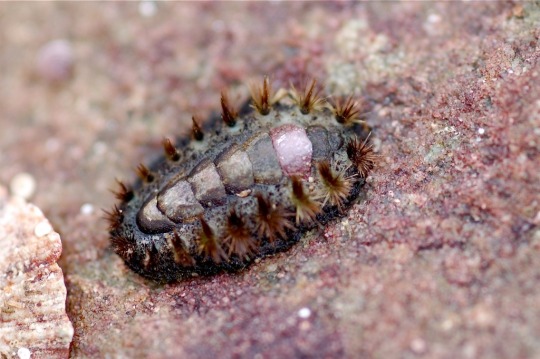
(source)
77 notes
·
View notes
Text
⋯ paleontology themed id pack !!

names ⁘
fossil ⋄ trilo ⋄ dino ⋄ cambria ⋄ amber ⋄ nuna ⋄ shale ⋄ marrella ⋄ archo ⋄ azhdarcho ⋄ strata ⋄ phyla ⋄ devon(ia) ⋄ mosa ⋄ darwin ⋄ finch ⋄ kimberella ⋄ pteraspi ⋄ stega ⋄ raptor ⋄ burgess ⋄ holocene ⋄ lichida ⋄ luca ⋄ zircon ⋄ ediacara
trilo: as in trilobite | cambria: the cambrian period | amber: where many insects are preserved | nuna: one of the oldest supercontinents | archo: as in archosaur | azhdarcho: as in a group of large pterosaurs | strata: as in stratigraphy | devonia: the devonian period | finch: darwin's finches | stega: as in stegosaur | burgess: the burgess shale, british columbia | lichida: a group of trilobites | luca: last universal common ancestor | zircon: a crystal that can help search for early microbial life | ediacara: the ediacaran period

pronouns ⁘
paleo/paleo ⋄ fossil/fossils ⋄ dig/digs ⋄ dino/saur ⋄ dino/dinos ⋄ geo/geology ⋄ phy/phylum ⋄ tri/trilobite ⋄ bone/bones ⋄ mammoth/mammoths ⋄ flora/fauna ⋄ zo/zoa ⋄ tetra/tetrapod ⋄ evo/evolve

titles ⁘
The Most Ancient ⋄ (prn) Who Swims with Ichthyosaurs ⋄ The Fossilized One ⋄ (prn) Who is Encased in Stone ⋄ The Ancestor of Life ⋄ The Driver of Evolution

system names ⁘
the burgess shale ⋄ the fossil dig ⋄ the cycling lands ⋄ prehistoric pack ⋄ mesozoic menagerie ⋄ the index ⋄ heart of ediacara

As a certified paleontology nerd with a tattoo of a cheirurus trilobite and an anomalocaris.... this was absolutely necessary. -Iris (she/her)
credit: 1, 2
#cosmozoa— id pack 🌌#id pack#endo friendly#mogai friendly#name ideas#name suggestions#pronoun ideas#pronoun suggestions#system names#titles#npt#npts#npt list#npt ideas#npt suggestions#title suggestions#name list#neopronouns#noun names#unique names
144 notes
·
View notes
Text

DINOSAUR ID PACK

NAMES ︰ amber. andrew. archie. archo. aroara. azhdarcho. bailey. barney. bowser. bronto. burgess. cambria. cera. charlie. cory. daemon. darwin. dee. devon. devonia. dina. dino. dinora. draco. eddie. ediacara. eli. felix. finch. finn. fleet. fossil. grover. holocene. huxley. jade. kaisen. kermit. kimberella. leo. lichida. luca. marrella. max. mite. mosa. nuna. oscar. phyla. pteraspi. quetzal. raptor. rex. rexie. reximus. rexley. rhino. roardin. roarke. rocky. ronaldino. roryn. roy. sage. sara. scout. shale. spike. stega. strata. tank. theodore. thesaurus. thumper. trexler. trilo. ty. verdi. ziggy. zircon.

PRONOUNS︰ bone/bone. cera/cera. cera/top. cerat/cerat. ceratops/ceratop. claw/claw. dig/dig. dino/dino. dino/saur. dinosaur/dinosaur. don/don. evo/evolve. flora/fauna. fluff/fluff. foss/fossier. fossi/fossi. fossil/fossil. geo/geology. hx/hxm. hy/hym. jur/jurassic. mammoth/mammoth. mim/mim. mimu/mimus. mimus/mimus. paleo/paleo. paleon/paleon. phy/phylum. plush/plushy. pteryx/pteryx. rapt/rapt. raptor/raptor. rawr/rawr. rex/rex. roar/roar. saur/saur. saur/saurus. saurus/saurus. scale/scale. shx/hxr. shy/hyr. spino/spino. teeth/teeth. tetra/tetrapod. thxy/thxm. thy/thym. tri/trilobite. tyra/tyra. tyrant/tyrant. tyras/tyrant. ven/ven. vena/vena. venator/venator. zo/zoa. ⭐ . 🌋 . 🍖 . 🦕 . 🦖 . 🦴 .

#pupsmail︰id packs#id pack#npt#name suggestions#name ideas#name list#pronoun suggestions#pronoun ideas#pronoun list#neopronouns#nounself#emojiself#dinokin#dino therian#dinosaurkin#dinosaur therian#paleocore
95 notes
·
View notes
Text
Perspectives #4

"Silent Sea" Dickinsonia/Kimberella/Tribrachidium Ediacaran, 556 million years ago, Ediacara Hills (Australia)
The Ediacaran Biota were a motley crew of strange animals of lineages unseen anywhere else. Many of them break traditional symmetry, and most were soft-bodied. Dickinsonia, the background critter, was a proarticulate displaying glide symmetry (probably), a sort of staggered segmentation unseen in any animal today. It slowly crawled over the seabed, grazing on microbial mats. Kimberella are the slugs, probably distantly related to today's mollusks. It seems like the overall plan of "lay low, have a shell and crawl on the floor" has served them well. Tribrachidium are the spiral guys, small filter feeders that used their unique shape to funnel water into their centers. Triradial symmetry is similarly unseen in modern life.
This is part 3 of my Perspectives series! For more, check out #perspectives on my blog.
#paleoart#ediacaran#precambrian#perspectives#yee art#ocean#nature art#nature#paleoblr#palaeoblr#paleobiology#paleontology
34 notes
·
View notes
Text








Ediacara! If there’s any others I’m missing let me know!
Dickinsonia - Charnia
Spriggina - Mawsonites
Aspidella - Kimberella
Parvancorina - Tribrachidium
Shop || Phone Wallpapers
49 notes
·
View notes
Text
Hemaslime, the Oxidized Armor Pokemon!
Type: Fire/Steel
Evolves from Kiffer while holding an Iron Ball When a Kiffer becomes more experienced in its fire usage, it begins to melt nearby rocks into hardened iron sheets. It uses these to form a shell around its rear, evolving into a Hemaslime. These creatures sift through the sediment for detritus and burrowing organisms to eat, as well as for more materials to plaster on their backs and to strengthen their shells.

#pokemon#fakemon#carbohs#natural history#paleontology#paleoblr#paleoart#evolution#mollusc#volcano snail#kimberella
5 notes
·
View notes